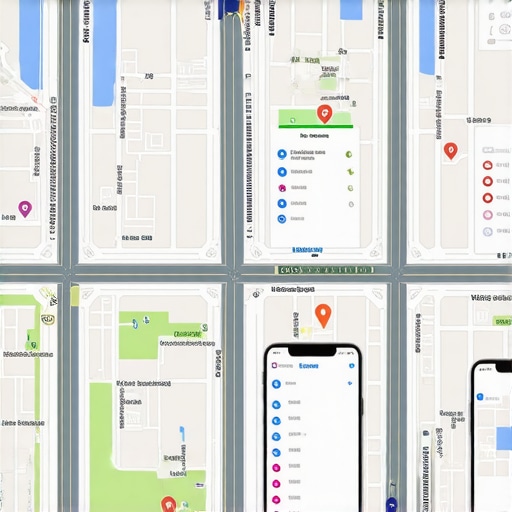Elevating Your Local Search Authority: The Foundation of Maps SEO in 2024
In the rapidly evolving landscape of local search, understanding the nuanced mechanics of Google Maps SEO is paramount for businesses seeking sustained visibility. The core challenge lies in mastering the complex interplay between local ranking factors, user intent, and algorithmic updates. By leveraging proven techniques such as optimizing Google My Business (GMB) profiles, harnessing schema markup, and cultivating authoritative local citations, marketers can significantly enhance their local search presence.
Deciphering the Algorithmic Pulse: How Google Ranks Maps Results in 2024
Google’s ranking algorithm for Maps is a sophisticated amalgamation of proximity, relevance, and prominence. Recent white papers and case studies underscore the importance of localized content, review signals, and behavioral metrics. Advanced practitioners employ tools like Maps SEO strategies to decode ranking patterns and adapt their tactics accordingly. The integration of AI-driven insights allows for predictive adjustments, ensuring that businesses stay ahead of competitors.
What are the key technical elements that influence local rankings and how can they be optimized effectively?
Technical optimization in Maps SEO involves ensuring accurate NAP (Name, Address, Phone Number) consistency, fast-loading mobile-friendly website architecture, and schema markup implementation. Employing structured data not only enhances visibility in local packs but also signals to Google the relevance of your business within specific localities. A comprehensive audit of local citations and backlinks further consolidates authority, as emphasized in effective SEO ranking tips.
Leveraging User Engagement and Reviews: The Unsung Heroes of Maps SEO
Beyond technical factors, user-generated signals such as reviews, ratings, and engagement metrics are critical for ranking success in 2024. Encouraging satisfied customers to leave positive reviews enhances credibility and prominence within local searches. Moreover, responding to reviews demonstrates active reputation management, fostering trust and encouraging further interaction. Integrating review management tools and monitoring sentiment analysis can provide actionable insights for continuous improvement.
Anticipating Future Trends: AI, Voice Search, and Personalized Local Results
As the landscape shifts, emerging technologies like AI-driven search personalization and voice search optimization are reshaping Maps SEO strategies. Implementing structured data for voice queries and tailoring content for conversational search intents are vital for future-proofing your local SEO efforts. Staying informed through authoritative sources such as the Search Engine Journal can provide valuable foresight into upcoming algorithmic shifts and best practices.
How can local businesses integrate advanced analytics to measure and refine their Maps SEO performance?
Utilizing tools like Google Search Console, Google Analytics, and specialized local SEO dashboards enables granular tracking of visibility metrics, user behavior, and conversion pathways. Advanced analytics facilitate A/B testing of optimization tactics and help identify high-impact strategies for ongoing refinement. Continuous monitoring and adaptation are essential for maintaining an edge in competitive local markets.
For professionals committed to elevating their local search dominance, exploring comprehensive resources and sharing insights within industry forums is invaluable. Engage with the community to exchange best practices and stay ahead in the dynamic world of Maps SEO.
Harnessing the Power of Local Schema Markup for Competitive Edge
One often overlooked yet highly effective tactic in Maps SEO is the strategic implementation of local schema markup. Structured data not only enhances search engine understanding of your business details but also increases the likelihood of rich snippets and local pack features. For instance, adding LocalBusiness schema with detailed attributes such as opening hours, services, and geographic coordinates can significantly boost your visibility. According to Moz’s expert insights, leveraging schema markup is a vital step in comprehensive local SEO strategies, especially as search engines become more sophisticated in interpreting structured data (Moz, 2023).
Can AI-Powered Tools Revolutionize Your Maps SEO Strategy?
Absolutely. Advanced AI tools like ChatGPT, SEMrush’s Local SEO tools, and BrightLocal’s reputation management platforms are transforming how businesses approach Maps SEO. These tools analyze vast amounts of data, predict ranking trends, and provide actionable insights, enabling hyper-targeted optimization efforts. For example, AI-driven sentiment analysis of reviews can help identify reputation issues before they impact rankings. Integrating these technologies into your SEO workflow can lead to more precise targeting, better resource allocation, and sustained local dominance. To explore the latest AI innovations in local SEO, consider resources like effective Maps SEO techniques.
What are the emerging data sources and tools that can provide a competitive advantage in Maps SEO for 2024?
Emerging data sources such as real-time foot traffic analytics, social media check-ins, and hyperlocal weather patterns are starting to influence local search algorithms. Tools like Placer.ai, Geofencing, and Nextdoor analytics furnish granular insights into consumer behavior, enabling businesses to tailor their local content and offers accordingly. Additionally, integrating AI-powered CRM systems can help track customer interactions across channels, creating a unified view of local engagement. Staying ahead of the curve requires not only adopting these innovative sources but also understanding how they influence Google’s ranking factors. For a deep dive into these technologies, see Maps SEO strategies.
Finally, engaging with industry-specific forums and attending local SEO webinars can provide ongoing education and peer insights, which are crucial in this fast-changing landscape. Sharing your experiences and learning from others is a proven way to refine your Maps SEO tactics continually.
Harnessing Localized Content Development for Hyper-Targeted Maps Visibility
In the quest for local search supremacy, content remains king—yet, not just any content will do. Advanced practitioners emphasize the importance of creating hyper-localized, contextually rich content that resonates with community-specific interests and needs. This includes developing detailed landing pages for neighborhoods, integrating local event coverage, and utilizing user-generated content to foster community trust and engagement. Employing tools like SEMrush’s Keyword Gap analysis can reveal underserved local topics, guiding content creation efforts that capture niche search intents.
What sophisticated content strategies can elevate local rankings beyond basic optimization?
Implementing schema-based storytelling, such as customer success stories with embedded local keywords, enhances both relevance and user engagement. Moreover, leveraging dynamic content modules that update with local news or weather conditions can signal ongoing activity and relevance to Google’s algorithms. According to a 2024 Moz Local Search Ranking Factors report, such contextual signals are increasingly weighted in local ranking calculations, highlighting the need for continuous content refreshment and localization precision.
Integrating Advanced Technical SEO for Resilient Map Rankings
Technical excellence is foundational. Beyond fundamental schema markup, sophisticated schema implementations—like Product schema for local inventory, Event schema for community happenings, and FAQ schema for common local queries—can drastically enhance visibility. Ensuring robust website architecture with server-side rendering capabilities ensures fast load times, even on mobile devices, which are critical for local searches. An in-depth audit using Google’s Lighthouse and Schema Pro can identify and rectify issues that impede performance and rich snippet eligibility.
How can emerging technologies like edge computing and 5G impact local SEO performance?
Edge computing and 5G networks significantly reduce latency, enabling real-time data processing and instant content delivery. This technological leap allows local businesses to deploy highly personalized, location-aware content instantly, dramatically improving user experience and engagement. As highlighted in a recent Gartner report, these advancements could lead to an evolution in Maps SEO, where the immediacy of data influences ranking signals, demanding new optimization tactics centered around real-time relevance.
Leveraging Local Data Analytics for Predictive Optimization
Advanced analytics now extend beyond basic metrics, incorporating predictive modeling and machine learning algorithms to forecast trends and user behaviors. By integrating data from sources like Placer.ai and Nextdoor, businesses can anticipate local demand shifts and adjust their content, offers, and GMB strategies proactively. This approach, often termed ‘predictive local SEO,’ is gaining traction among industry leaders seeking a competitive edge. Implementing these insights requires sophisticated dashboards and a team skilled in data science, but the payoff is a highly targeted, effective local SEO blueprint.
What are the best practices for leveraging real-time foot traffic and social media check-ins to boost local search rankings?
Real-time foot traffic data provides invaluable insights into optimal store hours, staffing, and promotional timing. Coupling this with social media check-ins enhances local relevance signals to Google, reinforcing your physical presence. Encouraging customers to share their experiences via branded hashtags and geotags creates a wealth of fresh, user-generated content that boosts your local prominence. Integrating these signals into your local SEO strategy aligns with Google’s increasing emphasis on social proof and behavioral metrics, as detailed in a 2024 Search Engine Journal analysis.
To stay ahead, local businesses should continually refine their data-driven strategies and leverage cutting-edge tools. Engaging with industry forums, attending webinars, and participating in local SEO communities ensures you remain informed about evolving best practices, empowering your enterprise to dominate local search results well into 2024 and beyond.
Harnessing the Power of Local Data Integration for Next-Level Maps SEO
As local search algorithms become increasingly sophisticated, integrating diverse data sources is no longer optional but essential. Combining real-time foot traffic analytics, social media check-ins, and hyperlocal weather patterns enables businesses to craft hyper-targeted content that resonates with community-specific needs. Tools like Placer.ai and Geofencing provide granular insights, allowing for dynamic adjustments in marketing strategies that align with current consumer behaviors. This multidimensional approach not only boosts visibility but also enhances user engagement by delivering highly relevant experiences.
Exploring the Impact of Edge Computing and 5G on Local Search Performance
The advent of edge computing and 5G technology is revolutionizing the landscape of local SEO. These advancements drastically reduce latency, facilitating instant content delivery and real-time personalization. Businesses can now deploy location-aware applications that respond immediately to user interactions, creating seamless, engaging experiences. According to Gartner’s recent report, these technologies will influence ranking signals by prioritizing immediacy and relevance, prompting a paradigm shift in optimization tactics. Embracing these innovations ensures that your local SEO strategy remains resilient and future-proof.
Can Predictive Analytics Transform Your Local SEO Approach?
Absolutely. Leveraging predictive modeling and machine learning algorithms from platforms like Nextdoor and local SEO dashboards empowers businesses to anticipate market trends and user preferences. This proactive approach, termed ‘predictive local SEO,’ allows for strategic content planning, offer timing, and resource allocation. Advanced analytics reveal patterns and opportunities that traditional methods might overlook, providing a competitive edge in crowded markets. Investing in these technologies fosters a data-driven culture that continuously refines and elevates your local search presence.
What Role Does User-Generated Content Play in Reinforcing Local Search Authority?
Beyond technical optimization, user-generated content such as reviews, social media check-ins, and local event participations significantly reinforce local search authority. Encouraging customers to share their experiences with branded hashtags and geotags creates a steady stream of fresh, authentic signals that improve ranking relevance. Integrating sentiment analysis tools helps identify reputation issues early, enabling swift corrective actions. Cultivating a vibrant local community through user engagement not only boosts visibility but also builds trust and loyalty among prospective customers.
How Can Advanced Schema Markup Elevate Your Local Visibility?
Implementing sophisticated schema markup remains a cornerstone of effective local SEO. Beyond basic LocalBusiness schemas, deploying Product, Event, and FAQ schemas tailored to local contexts enhances search engine understanding and enriches search result snippets. Employing server-side rendering ensures rapid load times vital for mobile users. As search engines grow more adept at interpreting structured data, these enhancements translate directly into higher click-through rates and prominence within local packs. Regular schema audits using tools like Schema Pro ensure ongoing compliance and optimization.
What Are the Best Practices for Leveraging AI-Powered Optimization Tools?
AI-powered tools such as BrightLocal, SEMrush’s Local SEO suite, and sentiment analysis platforms enable hyper-targeted, efficient optimization. These technologies analyze vast datasets to predict ranking fluctuations, identify content gaps, and monitor reputation health. Incorporating AI-driven insights into your workflow allows for precise resource allocation and continuous strategy refinement. Engaging with industry webinars and communities accelerates mastery of these tools, ensuring your local SEO efforts remain agile and impactful in a competitive environment.
How Do Emerging Data Sources Enhance Your Local Search Strategy?
Emerging data sources like real-time foot traffic analytics, social media check-ins, and hyperlocal weather data inform smarter decision-making. Platforms such as Placer.ai and Geofencing furnish detailed behavioral insights, enabling hyperlocal targeting. Integrating AI-powered CRM systems provides a unified customer interaction view, facilitating personalized marketing. Staying informed through authoritative sources like Search Engine Journal equips marketers with the latest tactics to leverage these data streams effectively, ensuring sustained local search dominance.
Developing Hyper-Localized Content That Resonates and Ranks
Creating hyper-localized, contextually rich content is crucial for standing out. This involves developing neighborhood-specific landing pages, integrating local event coverage, and utilizing user-generated community stories. Using tools like SEMrush’s Keyword Gap analysis uncovers underserved topics and search intents, guiding targeted content creation. Incorporating schema storytelling and dynamic updates related to local news or weather signals ongoing activity, which search engines interpret as relevance, thus elevating rankings and engagement.
Advanced Technical SEO for Resilient Map Rankings
Beyond foundational schema markup, sophisticated implementations such as Product, Event, and FAQ schemas tailored to local contexts significantly enhance visibility. Ensuring website architecture supports server-side rendering and fast load times on mobile devices is critical. Regular audits with tools like Google’s Lighthouse and Schema Pro identify and rectify issues that hinder rich snippet eligibility. Embracing emerging technologies like edge computing and 5G further optimizes data delivery, enabling real-time, location-specific content that aligns with Google’s evolving ranking signals.
How Can Local Businesses Use Predictive Analytics for Continuous Optimization?
By integrating advanced data sources and predictive modeling, businesses can forecast demand and user behavior shifts, allowing for preemptive strategic adjustments. Tools like Placer.ai and Nextdoor analytics facilitate granular insights into local market trends, guiding content, offers, and GMB updates proactively. This anticipatory approach, often called ‘predictive local SEO,’ requires sophisticated dashboards and data science expertise but results in a highly responsive and effective local search strategy. Regularly reviewing these insights ensures your tactics stay aligned with evolving consumer preferences and search engine algorithms.
Final Call: Embrace Innovation to Dominate Local Search in 2024
Staying ahead in Google Maps SEO demands a relentless pursuit of innovation, data mastery, and technical excellence. By integrating emerging technologies, leveraging predictive analytics, and crafting hyper-localized content, your business can achieve unparalleled visibility and engagement. Continuous learning through authoritative industry sources, webinars, and community engagement is essential to adapt swiftly to algorithmic shifts and technological breakthroughs. Take proactive steps today to elevate your local search strategy and secure your position at the forefront of your market.
Expert Insights & Advanced Considerations
1. Prioritize hyper-localized content development that aligns with community interests, leveraging schema storytelling to boost relevance.
Developing neighborhood-specific landing pages, integrating local news, and utilizing user-generated stories can significantly enhance local relevance signals, which are increasingly weighted in ranking algorithms.
2. Embrace predictive analytics and machine learning to forecast local demand shifts, enabling proactive adjustments to your Maps SEO strategy.
Tools like Placer.ai and Nextdoor analytics offer granular insights, allowing businesses to stay ahead of trends and adapt content and offers accordingly, fostering sustained dominance.
3. Integrate emerging data sources such as real-time foot traffic, social check-ins, and hyperlocal weather data to refine targeting and content personalization.
Platforms like Geofencing and AI-enhanced CRM systems enable hyperlocal targeting, creating more engaging and relevant user experiences that improve rankings and engagement.
4. Implement advanced technical SEO, including sophisticated schema markup (Product, Event, FAQ schemas) and support for edge computing, to enhance speed, relevance, and rich snippets.
Regular audits with tools like Schema Pro and Google’s Lighthouse ensure technical excellence, while edge computing facilitates real-time content delivery aligned with Google’s evolving ranking signals.
5. Leverage AI-powered tools for sentiment analysis, reputation management, and content optimization, ensuring your Maps SEO efforts are data-driven and agile.
Platforms like BrightLocal and SEMrush’s Local SEO suite analyze vast datasets, predict trends, and guide resource allocation, providing a competitive edge in local search.
Curated Expert Resources
- Google’s Official Search Central Blog: Offers the latest updates on algorithm changes, best practices, and technical guidelines directly from Google.
- Moz’s Local Search Ranking Factors: An authoritative resource that provides in-depth analysis of ranking factors, including expert insights on schema markup and local content strategies.
- Search Engine Journal: Features comprehensive articles and case studies on innovative local SEO tactics, emerging technologies, and industry trends.
- BrightLocal’s Blog and Tools: Specializes in reputation management, review signals, and local analytics, essential for expert-level Maps SEO strategies.
- Gartner Reports on Edge Computing & 5G: Provide insights into how emerging technologies are influencing real-time personalization and relevance in local SEO.
Final Expert Perspective
In navigating the complex landscape of Google Maps SEO in 2024, mastery of hyper-localized content, predictive analytics, and cutting-edge technical SEO is paramount. By integrating emerging data sources and leveraging AI-driven tools, businesses can not only improve rankings but also deliver hyper-relevant experiences that resonate with local audiences. Engaging with authoritative resources ensures you remain at the forefront of industry evolution. For those committed to excellence, continuous innovation and data-driven refinement are your most reliable strategies. Dive deep into these resources, share your insights with industry peers, and let your local search dominance be a testament to your expertise and foresight.



